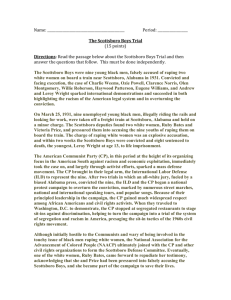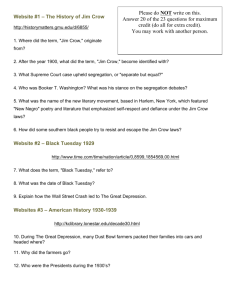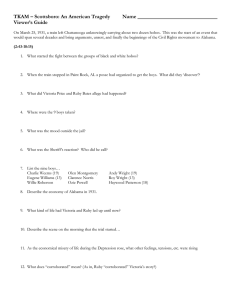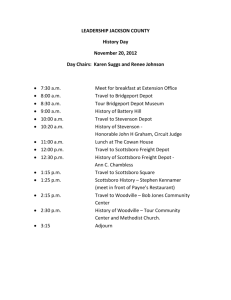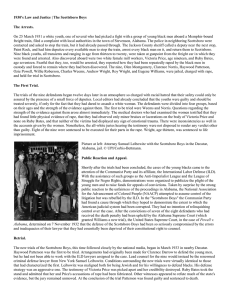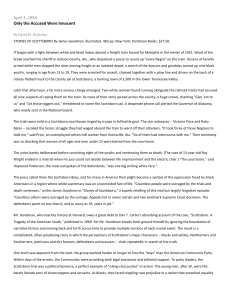1. Question
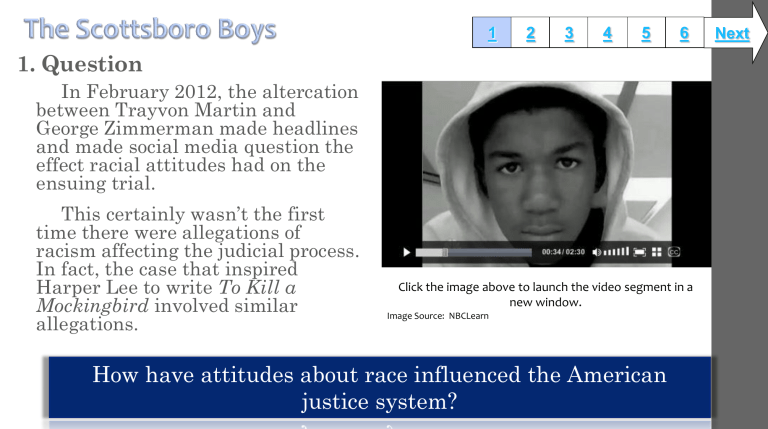
1. Question
In February 2012, the altercation between Trayvon Martin and
George Zimmerman made headlines and made social media question the effect racial attitudes had on the ensuing trial.
This certainly wasn’t the first time there were allegations of racism affecting the judicial process.
In fact, the case that inspired
Harper Lee to write To Kill a
Mockingbird involved similar allegations.
Click the image above to launch the video segment in a new window.
Image Source: NBCLearn
How have attitudes about race influenced the American justice system?
2. Information Sources
In March of 1931, a crime allegedly occurred on a train in Alabama. Click the links to learn more about the accusations and the aftermath.
•
1931-1937
•
Overview of Case
•
Worldbook Summary
•
Court Decisions to 1972
•
Chronology, Letters & Testimony
•
The People Involved (what happened later)
•
1934-1989
•
Diagram of the Train
•
Posthumous Pardons in 2013
The Scottsboro Boys
Image Source: Discovery Education, by subscription.
3. Student Activity
Using the resources on slide
2 , take notes on this timeline
of events related to the
Scottsboro Trial. How did prevailing attitudes about race affect the judicial proceedings over time?
Construct a digital timeline of the events using Tiki-toki ,
Prezi , Timetoast , or
ReadWriteThink .
Eight of the nine Scottsboro defendants
Image Source: Public domain
4. Assessment Activity
In a well-developed paragraph, answer the following:
How did changing attitudes about race alter the outcome of the Scottsboro Boys’ Trial?
Use information from your timeline to support your explanation. Your explanation will be scored using this rubric or another method as specified by your teacher.
Click the image to open a video about the
Scottsboro Boys and The Communist Party.
Image Source: NBC Learn, by subscription.
5. Enrichment Activities
Click the image to open the video in your browser.
Image Source: NBCLearn, by subscription.
View the video to the left. How may have past legal injustices have affected subsequent legal proceedings? Do you agree or disagree with the assertions made in the film clip? How may we ensure that trials are free from bias?
Create a 30-second public service announcement explaining the role and responsibilities of a jury to potential jurors.
You may use Animoto , Windows Movie
Maker, or another tool as approved by your teacher.
6. Teacher Support Materials
Grade Level and Content Area
BCPS Curriculum : English 9
Common Core State Standards
Reading: 1. Read closely to determine what the text says explicitly and to make logical inferences from it; cite specific textual evidence when writing or speaking to support conclusions drawn from the text.
Writing: 7. Conduct short as well as more sustained research projects based on focused questions, demonstrating understanding of the subject under investigation.
W 9.3 D Use precise words and phrases, telling details, and sensory language to convey a vivid picture of the experiences, events, setting, and/or characters
Standards for the 21 st Century Learner
1.1.6 Read, view, and listen for information presented in any format (e.g. textual, visual, media, digital) in order to make inferences and gather meaning.
2.1.3 Use strategies to draw conclusions from information and apply knowledge to curricular areas, real-world situations, and further investigations.
ISTE NETS - National Educational Technology Standards for Students
3. Research and Information Fluency: Students apply digital tools to gather, evaluate, and use information.
b. Locate, organize, analyze, evaluate, synthesize, and ethically use information from a variety of sources and media.
4.
Critical Thinking, Problem Solving, and Decision
Making: Students use critical thinking skills to plan and conduct research, manage projects, solve problems, and make informed decisions using appropriate digital tools and resources. c.
Collect and analyze data to identify solutions and/or make informed decisions.
Time Frame: One 90 minute lesson
Differentiation strategies for this lesson:
• included in our BCPS-licensed databases, levels/Lexiles, and embedded dictionaries.
Learning Styles addressed in this lesson:
Notes to the teacher:
•
Collaborate with your school library media specialist to implement this lesson.
•
Headphones/speakers necessary for viewing videos.
Last updated: July 2014
Created by Heather Jennings , STAT teacher
BCPS Slam Dunk Research Model, Copyright 2013, Baltimore County Public Schools, MD, all rights reserved. The models may be used for educational, non-profit school use only.
All other uses, transmissions, and duplications are prohibited unless permission is granted expressly. This lesson is based on Jamie McKenzie’s Slam Dunk Lesson module .

